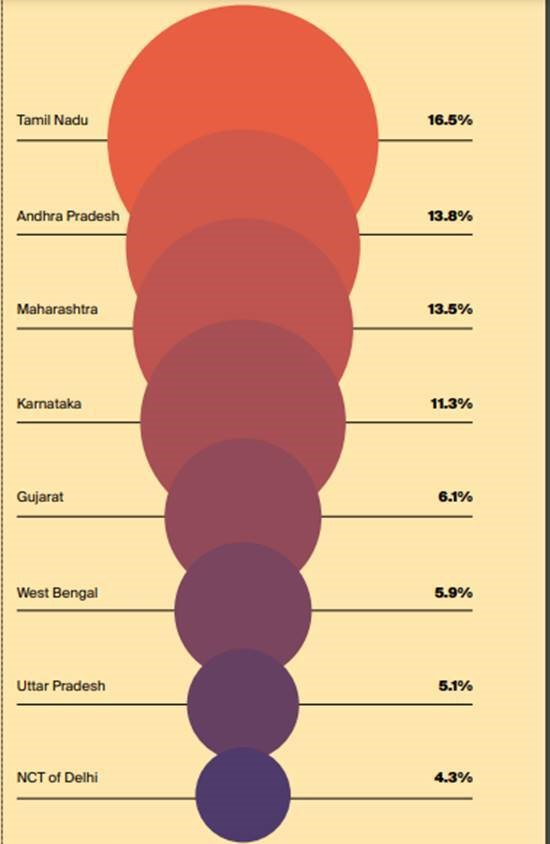According to a report by Knight Frank and Khaitan & Co., the Model Tenancy Act has far-reaching implications for both residential and commercial real estate asset classes, and will help stakeholders create a three-tiered regulatory ecosystem.
From a residential perspective, the research report titled ‘2021: A New Era for Rental Real Estate in India’ claims that India’s large vacant stock of total residential census houses can be brought into the fold of formal rental housing if states and union territories implement this Act in letter and spirit.

With this policy push, urban India’s 21.72 million rented households (Census of India, 2011) provide a huge market opportunity for market participants to focus on housing projects solely for rental purposes. 76.5 percent, or 16.63 million, of these urban rented households in India, reside across eight states and Union Territories (Census of India, 2011). The high proportion of total rented households in urban India can be attributed primarily to key urban employment hubs such as Chennai, Hyderabad, Mumbai, Pune, Bengaluru, Ahmedabad, Kolkata, and the National Capital Region (NCR).
STATES WITH THE HIGHEST PERCENTAGE SHARE OF RENTED HOUSEHOLDS IN INDIA

The Union Cabinet approved The Model Tenancy Act, 2021 in June 2021 for distribution to all states and UTs for adaptation by enacting new legislation or amending existing rental laws. The research report’s goal is to lay out the opportunities and challenges in the rental housing market.
It aims to create an effective regulation ecosystem in India that lays down the basic rules of a landlord-tenant relationship.
A lack of uniform laws related to rental housing tainted landlord-tenant relationships in the past due to trust issues.
Even though many states had previously adopted the Rent Control Act, there was a need for a dispute resolution mechanism because tenancy laws in India appeared as ‘pro-tenant.’
The lack of a regulatory framework to define both parties’ rights and obligations has always resulted in protracted legal battles.
Because the majority of the population in the top eight cities lives in informal rental housing, the new Act will present a huge opportunity for private housing operators and institutional investors in the organised rental housing market.
In the near future, India may be ready to introduce built-to-rent and built-to-own rental housing models.
The Model Tenancy Act, 2021 will create a long-term, efficient, and transparent rental housing marketplace in India.
The Act applies to both residential and commercial real estate. The framework includes an intention and promise to boost investment in both of these sectors by balancing the rights and obligations of the stakeholders, including prompt resolution of disputes.
Certain provisions, however, must be reconsidered, and the contractual rights of the parties should not be regulated, as such regulations will be frowned upon by investors seeking a return on their investment.
In order to develop and grow both sectors, investor sentiment and return on investment are important factors.
Key features of the Model Tenancy Act:
Creation of a three-tier redressal system
Rent Authorities, Rent Courts, and Rent Tribunals will arise as a result of the Act. As a result, these legal institutions will relieve the civil courts of the burden of tenancy disputes.
Security deposit demand capped
The Act limits the security deposit that a tenant must pay in advance to
a) not more than two months’ rent in the case of residential premises,
b) not more than six months’ rent in the case of non-residential premises.
Rights and obligation of landlords and tenants
The do’s and don’ts of each party (landlords and tenants) are clearly defined, covering a variety of topics such as the retention of original tenancy agreements, rents and other charges payable, property repair and maintenance, entry into premises, as well as information and duties of a property manager and the consequences of failure to perform necessary duties.
Eviction of tenants and recovery of possession of premises by the landlord
Previously, rent control acts in various states, like the Delhi Rent Control Act and the Maharashtra Rent Control Act, provided grounds for eviction that caused controversy in court.
This frequently resulted in protracted litigation. By limiting eviction and termination grounds, this Act seeks to address these issues at the ground level.
Role of property managers
The Model Tenancy Act, 2021, clearly defines the role of property managers, their responsibilities, and the consequences of any violations. Rent authorities will need to receive such information as the tenant’s name, PAN number, Aadhar number, address, and contact details.
This includes anyone who represents the landlord by managing the premises on his behalf, such as the rental agent. This Act will open up more opportunities for property managers in the future, particularly in the residential sector.
ALSO READ: Model Tenancy Act Brings Cheer To NRIs
Some challenges in the implementation of the Model Tenancy Act, 2021:
Meaning of ‘Premises’
In the Act, a premise defined as any part of a building intended for rental, except for a hotel, lodging, or property used for industrial use.
A state law may be needed to define how urban dwellings, such as slums and chawls, are classified.
Non-applicability for certain type of premises
Model Tenancy Act of 2021 exempts most publicly owned properties, including those owned by the government and businesses. This will keep a large number of leasable properties out of the regulatory framework.
Force Majeure
Given that the Act covers both commercial and residential transactions, force majeure should apply to both. Simply stating what constitutes Force Majeure and linking it to habitability may not be sufficient to assist stakeholders.
Digital platforms creation by the rent authority
In the digital age, real-time access to information is critical for making informed decisions. An online database could create by states in which information about tenants is available.
It is also possible to expand the database to include details of previous tenancies to assist in future quality indicators.
.

